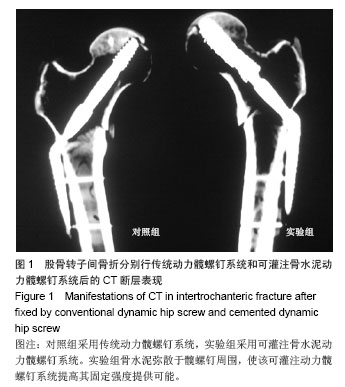Chinese Journal of Tissue Engineering Research ›› 2014, Vol. 18 ›› Issue (26): 4158-4162.doi: 10.3969/j.issn.2095-4344.2014.26.011
Previous Articles Next Articles
Advantages of cemented dynamic hip screw for osteoporotic intertrochanteric fracture
She Yuan-shi1, Chen Guang-xiang1, Chen Guang-dong1, Wang Yi-jin2, Zou Tian-ming1
- 1 Suzhou Hospital Affiliated to Nanjing Medical University, Suzhou 215002, Jiangsu Province, China; 2 Shanghai Institute of Biomechanics Engineering, Shanghai 200433, China
-
Online:2014-06-25Published:2014-06-25 -
Contact:Chen Guang-xiang, Chief physician, Suzhou Hospital Affiliated to Nanjing Medical University, Suzhou 215002, Jiangsu Province, China -
About author:She Yuan-shi, Master, Attending physician, Suzhou Hospital Affiliated to Nanjing Medical University, Suzhou 215002, Jiangsu Province, China -
Supported by:the Science and Technology Bureau Project of Suzhou City in China, No. SYSD2011059
CLC Number:
Cite this article
She Yuan-shi, Chen Guang-xiang, Chen Guang-dong, Wang Yi-jin, Zou Tian-ming. Advantages of cemented dynamic hip screw for osteoporotic intertrochanteric fracture[J]. Chinese Journal of Tissue Engineering Research, 2014, 18(26): 4158-4162.
share this article
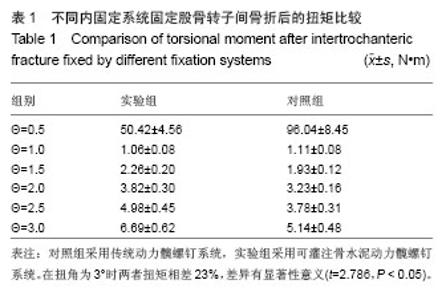
2.2 两组强度的比较 载荷1 200 N时,两组股骨转子间骨折内外侧的应力强度,实验组分别为(6.44±0.55),(6.72± 0.57) MPa,对照组分别为(3.03±0.27),(2.89±0.26) MPa,实验组比对照组分别高56%和57%,统计显示差异有显著性意义(t=3.378,P < 0.05)。 2.3 两组刚度的比较 分为股骨的轴向刚度和水平剪切刚度,实验组分别为(701.75±63.13) N/mm和(1 935.48± 164.45) N/mm,而对照组分别为(487.81±41.46) N/mm和(1 463.42±131.72) N/mm,两组比较,轴向刚度相差30%,水平剪切刚度相差24%,统计显示差异均有显著性意义(t=3.124,P < 0.05)。 2.4 两组扭转力学性能的比较 将标本近端股骨头包埋固定使股骨颈与扭转机的转轴在一直线,远端以可调夹具置于扭转力学实验机上,以0.032 (°)/s速度顺时针匀速增加扭转力,记录扭角大小。采用可灌注骨水泥动力髋螺钉系统固定股骨转子间骨折的扭矩,在扭角为3°时为(6.69±0.62) N·m,而常规动力髋螺钉系统的扭矩为(5.14±0.48) N·m,两者相差23%,差异有显著性意义(t=2.786,P < 0.05),见表1。 "
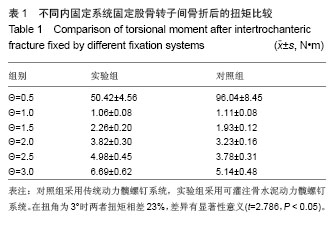
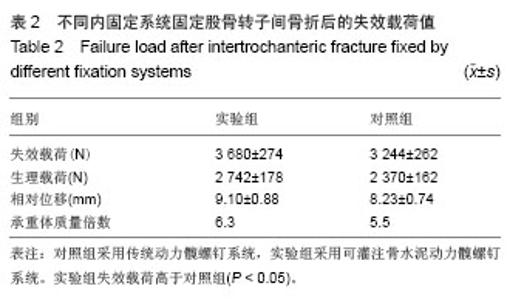
2.5 两组失效载荷的比较 按照Joseph等[28]的骨折固定失效判定标准:①大转子顶骨折断端皮质固定两点位移≥ 5 mm。②变形逐渐增加而负荷不增加甚至下降。③拉力螺钉后退超过10 mm。④主钉尖穿出股骨头。出现其中任何一种情况认为此时为固定的失效载荷。实验组动力髋螺钉固定能承受最大载荷为(3 680±274) N,相对位移(9.10± 0.88) mm;而对照组动力髋螺钉承受最大载荷为(3 244± 262) N,相对位移(8.23±0.74) mm,实验组强度高出对照组12%(t=2.654,P < 0.05),见表2。 从破坏形式来看,60%破坏发生在骨折处产生切割破坏,位移≥ 5 mm,转子间弯曲破坏占30%,只有10%主钉穿出股骨头。"
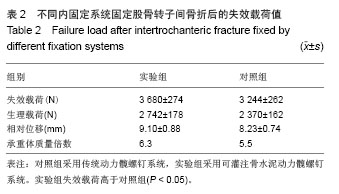
| [1]Liporace FA,Egol KA,Tejwani N,et al.What's new in hip fractures? Current concepts. Am J Orthop (Belle Mead NJ). 2005;34(2):66-74. [2]Jahng JS,Yoo JH,Sohn JS.The Relationship between the Fracutures of the Hip and the Bone Mineral Density over Fifty years.J Korean Orthop Surg.1997;32:46-52. [3]Mak JC,Cameron ID,March LM,et al.Evidence-based guidelines for the management of hip fractures in older persons: an update.Med J Aust.2010;192(1):37-41. [4]Boyd HB,Griffin LL.Classification and treatment of trochanteric fractures. Arch Surg.1949;58(6):853-863. [5]Ongkiehong BF,Leemans R.Proximal femoral nail failure in a subtrochanteric fracture:the 147 importance of fracture to distal locking screw distance.Inj Extra. 2007;38:445-450. [6]Pajarinen J,Lindahl J,Michelsson O,et al.Pertrochanteric femoral fractures treated with a dynamic hip screw or a proximal femoral nail. A randomised study comparing post-operative rehabilitation. J Bone Joint Surg Br.2005;87:76-81. [7]Saudan M,Lubbeke A,Sadowski C,et al.Pertrochanteric fractures: is there an advantage to an intramedullary nail?a randomized, prospective study of 206 patients comparing the dynamic hip screw and proximal femoral nail.J Orthop Trauma.2002;16(6):386-393. [8]Parker MJ,Handoll HH.Gamma and other cephalocondylic intramedullary nails versus extramedullary implants for extracapsular hip fractures in adults.Cochrane Database Syst Rev.2008;(3):CD000093. [9]Seibert FJ,Schippinger G,Szyszkowitz R.Invited commentary to:‘Gamma nail versus dynamic hip screw in 120 elderly patients-a randomised trial’. Eur Surg. 1997; 29: 294-295. [10]Menezes DF,Gamulin A,Noesberger B.Is the proximal femoral nail a suitable implant for treatment of all trochanteric fractures? Clin Orthop Relat Res.2005;439: 221-227. [11]Laohapoonrungsee A,Arpornchayanon O,Phornputkul C.Two-hole side-plate DHS in the treatment of intertrochanteric fracture: results and complications. Injury. 2005;36(11):1355-1360. [12]Davis TRC,Sher JL,Horsman A,et al.Intertrochanteric femoral fractures. Mechanical failure after internal fixation.J Bone Joint Surg Br.1990;72(1):26-31. [13]Evans EM .The treatment of trochanteric fractures of the femur. J Bone Joint Surg Br.1949;31:190-203. [14]Flores LA,Harrington IJ,Heller M.The stability of intertrochanteric fractures treated with a sliding screw-plate.J Bone Joint Surg Br.1990;72(1):37-40. [15]Laros GS,Moore JF.Complications of fixation in intertrochanteric fractures. Clin Orthop.1974;101:110-119. [16]Madsen JE,Naess L,Aune AK,et al.Dynamic hip screw with trochanteric stabilising plate in the treatment of unstable proximal femoral fractures. A comparative study with Gamma nail and compression hip screw.J Orthop Trauma.1998; 12(4): 241-248. [17]Evans EM.Trochanteric fractures; a review of 110 cases treated by nail-plate fixation.J Bone Joint Surg Br.1951; 33B(2):192-204. [18]Liu M,Yang Z,Pei F,et al.A meta-analysis of the Gamma nail and dynamic hip screw in treating peritrochanteric fractures. Int Orthop.2010;34(3):323-328. [19]Oger P,Katz V,Lecorre N,et al.Fracture of the greater trochanter treated by dynamic hip screw plate: measure of impaction according to fracture type. Rev Chir Orthop Reparatrice Appar Mot.1998;84(6):539-545. [20]Rao JP,Banzon MT,Weiss AB,et al.Treatment of unstable intertrochanteric fractures with anatomic reduction and compression hip screw fixation. Clin Orthop.1983;175:65-71. [21]Thomas AP.Dynamic hip screws that fail.Injury.1991;22(1): 45-46. [22]Kyle RF,Gustilo RB,Premer RF.Analysis of six hundred and twenty-two intertrochanteric hip fractures. A retrospective and prospective study. J Bone Joint Surg Am.1976;61:216-221. [23]Parker MJ.Cutting-out of the dynamic hip screw related to its position. J Bone Joint Surg Br.1992;74:625. [24]Nordin S,Zulkifli O,Faisham WI.Mechanical failure of dynamic Hip Screw (DHS) fixation in intertrochanteric fracture of the femur.Med J Malaysia.2001;56:12-17. [25]Simpson AH,Varty K,Dodd CAF.Sliding hip screw:modes of failure.Injury.1989; 20:227-231. [26]郭继民,占晨光,董万超,等.髋部螺钉加骨水泥治疗老年人骨质疏松性股骨转子间骨折[J].创伤外科杂志,2006,8(4):325-327. [27]Swiontkowski MF,Harrington RM,Keller TS,et al.Torsion and bending analysis of internal fixation techniques for femoral neck fractures: the role of implant design and bone density.J Orthop Res.1987;5:433-444. [28]Joseph TN,Chen AL,Kummer FJ, et al.The effect of posterior sag on the fixation stability of intertrochanteric hip fractures.J Trauma.2002;52(3):544-547. [29]Zhao C,Liu DY,Guo JJ et al.Comparison of proximal femoral nail and dynamic hip screw for treating intertrochanteric fractures.Zhongguo Gu Shang. 2009;22(7):535-537. [30]Bonamo JJ, Accettola AB. Treatment of intertrochanteric fractures with a sliding nail-plate. J Trauma. 1982; 22: 205-215. [31]Kaufer H,Mattews LS,Sonstegard D.Stable fixation of intertrochanteric fracture. A biomechanical evaluation.J Bone Joint Surg Am.1974;56:899-907. [32]Kyle RF.Fractures of the proximal part of the femur.J Bone Joint Surg Am.1994;76:924-950. [33]Klinger HM,Baums MH,Eckert M,et al.Acomparative study of unstable per- and intertrochanteric femoral fractures treated with dynamic hip screw (DHS) and trochanteric butt-press plate versus proximal femoral nail (PFN). Zentralbl Chir. 2005; 130(4):301-306. [34]Kafer M,Palm M,Zwank L,et al.What influence does the implant have on the perioperative morbidity following internal fixation of proximal femur fracture? Analysis of dynamic hip screw and proximal femoral nailing. Z Orthop Ihre Grenzgeb. 2005;143(1):64-71. [35]Jones HW,Johnston P,Parker M.Are short femoral nails superior to the sliding hip screw? A meta-analysis of 24 studies involving 3279 fractures. Int Orthop.2006;30:69-78. [36]Mainds CC,Newman RJ.Implant failures in patients with proximal fractures of the femur treated with a sliding screw device. Injury.1986;20:98-100. [37]Pervez H,Parker MJ,Vowler S.Prediction of fixation failure after sliding hip screw fixation. Injury.2004;35:994-998. [38]Gundle R,Gargan MF,Simpson AH.How to minimize failure of fixation of unstable intertrochanteric fractures.Injury. 1995;26: 611-614. [39]Wu CC,Shih CH,Lee MY,et al.Biomechanical analysis of location of lag screw of a dynamic hip screw in treatment of unstable intertrochanteric fracture.J Trauma. 1996;41(4): 699-702. [40]Baumgaertner MR, Solberg BD. Awareness of tip-apex distance reduces failure of fixation of trochanteric fractures of the hip. J Bone Joint Surg Br.1997;79:969-971. [41]Baumgaertner MR, Curtin SL, Lindskog DM, et al. The value of the tip-apex distance in predicting failure of fixation of peritrochanteric fractures of the hip. J Bone Joint Surg Am. 1995;77(7):1058-1064. [42]Hsueh KK, Fang CK, Chen CM, et al. Risk factors in cutout of sliding hip screw in intertrochanteric fractures: an evaluation of 937 patients.Int Orthop.2010;34:1273-1276. [43]Lee PC, Hsieh PH, Chou YC, et al. Dynamic hip screws for unstable intertrochanteric fractures in elderly patients- encouraging results with a cement augmentation technique.J Trauma.2010;68(4):954-964. |
| [1] | Xu Feng, Kang Hui, Wei Tanjun, Xi Jintao. Biomechanical analysis of different fixation methods of pedicle screws for thoracolumbar fracture [J]. Chinese Journal of Tissue Engineering Research, 2021, 25(9): 1313-1317. |
| [2] | Chen Xinmin, Li Wenbiao, Xiong Kaikai, Xiong Xiaoyan, Zheng Liqin, Li Musheng, Zheng Yongze, Lin Ziling. Type A3.3 femoral intertrochanteric fracture with augmented proximal femoral nail anti-rotation in the elderly: finite element analysis of the optimal amount of bone cement [J]. Chinese Journal of Tissue Engineering Research, 2021, 25(9): 1404-1409. |
| [3] | Zhou Jihui, Li Xinzhi, Zhou You, Huang Wei, Chen Wenyao. Multiple problems in the selection of implants for patellar fracture [J]. Chinese Journal of Tissue Engineering Research, 2021, 25(9): 1440-1445. |
| [4] | Xu Yulin, Shen Shi, Zhuo Naiqiang, Yang Huilin, Yang Chao, Li Yang, Zhao Heng, Zhao Lu. Biomechanical comparison of three different plate fixation methods for acetabular posterior column fractures in standing and sitting positions [J]. Chinese Journal of Tissue Engineering Research, 2021, 25(6): 826-830. |
| [5] | Cai Qunbin, Zou Xia, Hu Jiantao, Chen Xinmin, Zheng Liqin, Huang Peizhen, Lin Ziling, Jiang Ziwei. Relationship between tip-apex distance and stability of intertrochanteric femoral fractures with proximal femoral anti-rotation nail: a finite element analysis [J]. Chinese Journal of Tissue Engineering Research, 2021, 25(6): 831-836. |
| [6] | Song Chengjie, Chang Hengrui, Shi Mingxin, Meng Xianzhong. Research progress in biomechanical stability of lateral lumbar interbody fusion [J]. Chinese Journal of Tissue Engineering Research, 2021, 25(6): 923-928. |
| [7] | Xie Chongxin, Zhang Lei. Comparison of knee degeneration after anterior cruciate ligament reconstruction with or without remnant preservation [J]. Chinese Journal of Tissue Engineering Research, 2021, 25(5): 735-740. |
| [8] | Nie Shaobo, Li Jiantao, Sun Jien, Zhao Zhe, Zhao Yanpeng, Zhang Licheng, Tang Peifu. Mechanical stability of medial support nail in treatment of severe osteoporotic intertrochanteric fracture [J]. Chinese Journal of Tissue Engineering Research, 2021, 25(3): 329-333. |
| [9] | Tan Jiachang, Yuan Zhenchao, Wu Zhenjie, Liu Bin, Zhao Jinmin. Biomechanical analysis of elastic nail combined with end caps and wire fixation for long oblique femoral shaft fractures [J]. Chinese Journal of Tissue Engineering Research, 2021, 25(3): 334-338. |
| [10] | Chen Lu, Zhang Jianguang, Deng Changgong, Yan Caiping, Zhang Wei, Zhang Yuan. Finite element analysis of locking screw assisted acetabular cup fixation [J]. Chinese Journal of Tissue Engineering Research, 2021, 25(3): 356-361. |
| [11] | Zhou Jihui, Li Xinzhi, Zhou You, Huang Wei, Chen Wenyao. Comparison of the advantages and disadvantages of multiple implants in treatment of traumatic dislocation of sternoclavicular joint [J]. Chinese Journal of Tissue Engineering Research, 2021, 25(3): 443-448. |
| [12] | Li Kun, Li Zhijun, Zhang Shaojie, Gao Shang, Sun Hao, Yang Xi, Wang Xing, Dai Lina . A 4-year-old child model of occipito-atlanto-axial joints established by finite element dynamic simulation [J]. Chinese Journal of Tissue Engineering Research, 2021, 25(24): 3773-3778. |
| [13] | Sun Maji, Wang Qiuan, Zhang Xingchen, Guo Chong, Yuan Feng, Guo Kaijin. Development and biomechanical analysis of a new anterior cervical pedicle screw fixation system [J]. Chinese Journal of Tissue Engineering Research, 2021, 25(24): 3821-3825. |
| [14] | Zhu Yun, Chen Yu, Qiu Hao, Liu Dun, Jin Guorong, Chen Shimou, Weng Zheng. Finite element analysis for treatment of osteoporotic femoral fracture with far cortical locking screw [J]. Chinese Journal of Tissue Engineering Research, 2021, 25(24): 3832-3837. |
| [15] | Liu Jinyu, Ding Yiwei, Lu Zhengcao, Gao Tianjun, Cui Hongpeng, Li Wen, Du Wei, Ding Yu. Finite element biomechanical study of full endoscopic fenestration decompression for cervical spondylotic myelopathy [J]. Chinese Journal of Tissue Engineering Research, 2021, 25(24): 3850-3854. |
| Viewed | ||||||
|
Full text |
|
|||||
|
Abstract |
|
|||||

